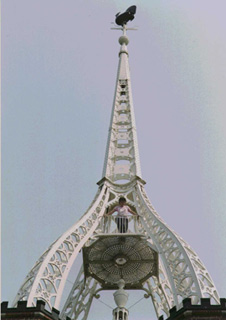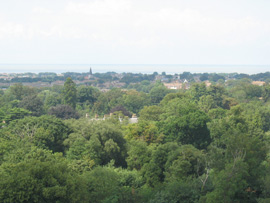WATERLOO
TOWER
BIRCHINGTON
KENT UK

The cast iron spire on top of the tower at Quex is very distinctive and can be seen above the surrounding trees. John Newman in his volume 'North East & East Kent' in Pevsner's 'The Buildings of England' series (3rd edition, published by Penguin in 1983) describes it as "a remarkably daring achievement for its date". It is much admired by 'folly fanatics'. In their book 'Follies, A Guide to Rogue Architecture in England, Scotland & Wales' published in 1986 by Jonathan Cape, Will Meulenkamp and Gwyn Headley describe it thus
"... but the most remarkable thing, the beauty which transcends workaday architecture and can make a folly into an object to be remembered for a lifetime, is the spire. The simplest way to describe it is as like the Eiffel Tower but more graceful, more ethereal; it is made of cast iron painted white, with each of its four convex bowed legs (not concave life Eiffel's) firmly planted on a corner turret."
It is possible to climb a ladder to a platform in the spire from where the best view of the surrounding countryside can be seen. At this level the name 'John Clark Ramsgate 1820' can be seen on plates on each of the legs of the spire. John Clark seems to have been the head carpenter on the Quex Estate in the 1820s when he is mentioned regularly in a little book of estate accounts, sometimes being given money to pay others. As the estate carpenter he probably made the patterns from which the sections of the spire were cast.

Also in the account book are payments to "Wm. Mackney for iron castings for the ringing tower". William Mackney was a millwright and ironfounder in the town of Sandwich ten miles south of Quex Park. It seems that this glorious structure, so much admired, was made by the estate carpenter and a local millwright. One can only marvel at the high standard of local craftsmanship in 1820. It is worth reflecting that the Eiffel Tower, which is often referred to in connection with the Quex spire, celebrated its centenary in the 1990s.